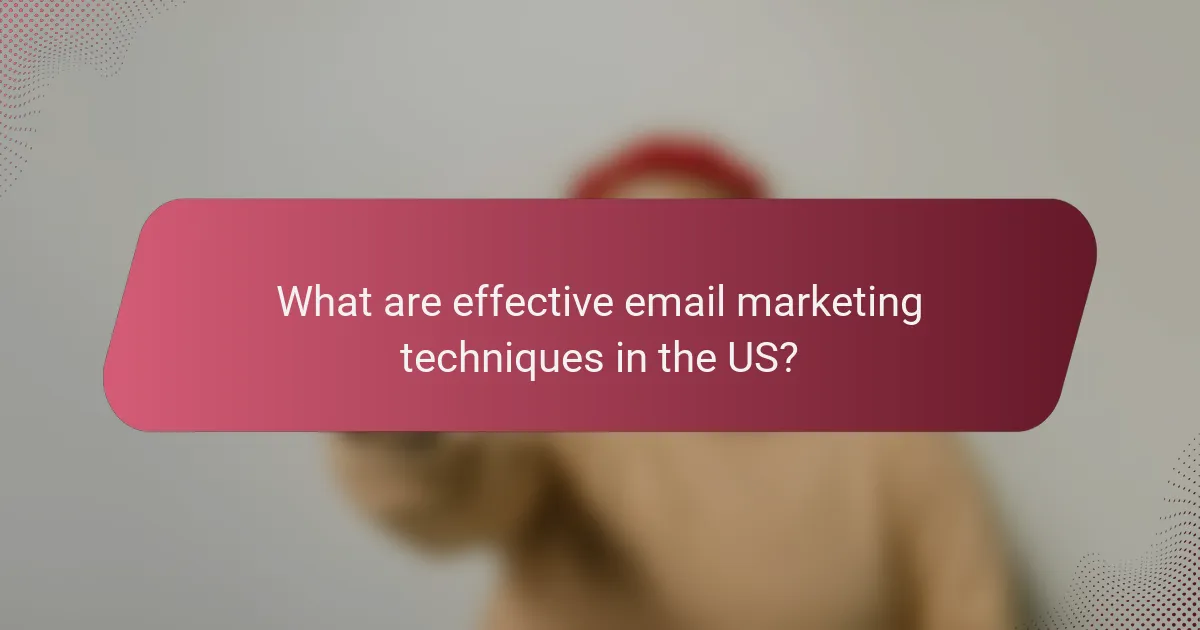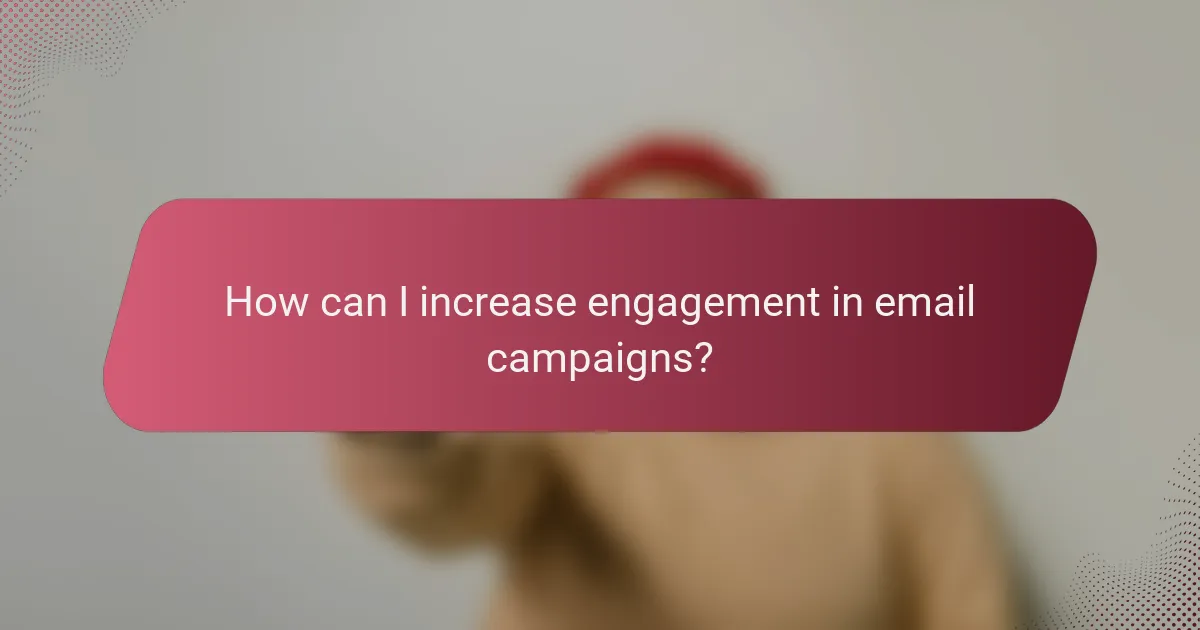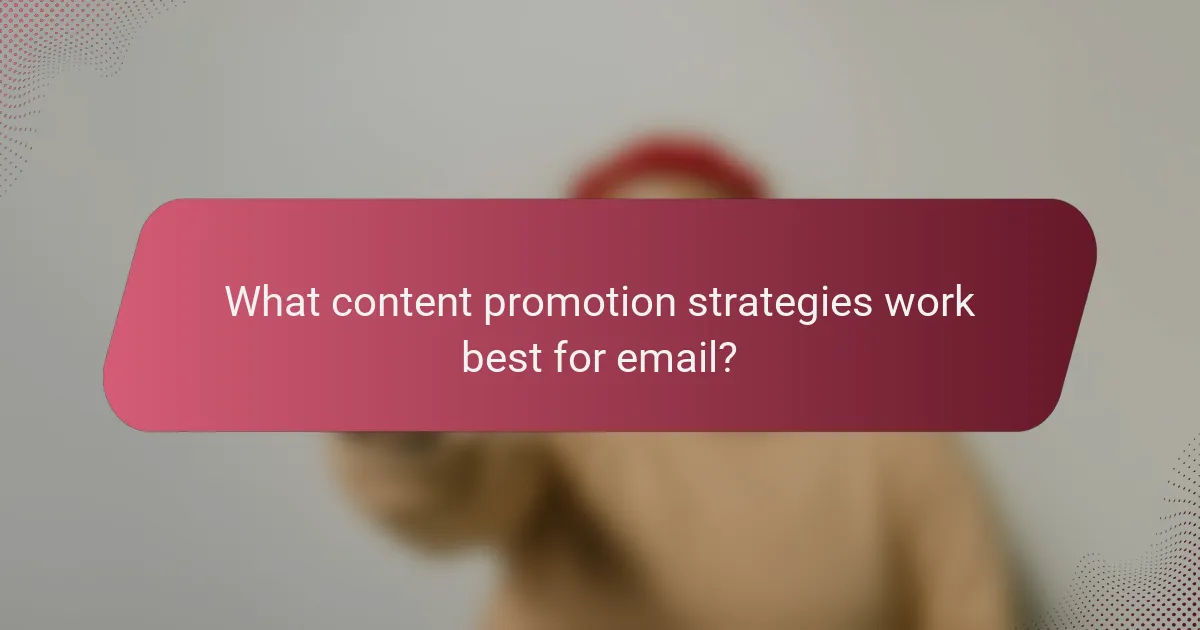Email marketing is a powerful tool that leverages personalization, segmentation, and automation to boost engagement and conversions. By crafting targeted campaigns that deliver valuable content and utilizing effective strategies like compelling subject lines and clear calls-to-action, businesses can significantly enhance their email performance and foster stronger connections with their audience.

What are effective email marketing techniques in the US?
Effective email marketing techniques in the US focus on personalization, segmentation, and automation to enhance engagement and drive conversions. By implementing these strategies, businesses can create targeted campaigns that resonate with their audience and improve overall performance.
Personalization strategies
Personalization strategies involve tailoring email content to individual recipients based on their preferences, behaviors, and demographics. This can include using the recipient’s name, recommending products based on past purchases, or sending birthday discounts. Personalized emails can significantly increase open and click-through rates.
To implement personalization effectively, consider using dynamic content that changes based on user data. Tools like Mailchimp or HubSpot can help automate this process, ensuring that each recipient receives relevant information that speaks directly to their interests.
Segmentation methods
Segmentation methods divide your email list into smaller groups based on specific criteria such as demographics, purchase history, or engagement levels. This allows for more targeted messaging, which can lead to higher engagement rates. For example, you might segment your list into new customers, repeat buyers, and inactive users.
Common segmentation criteria include geographic location, age, and past interactions with your emails. By analyzing these segments, you can craft tailored messages that address the unique needs and preferences of each group, ultimately improving your campaign’s effectiveness.
A/B testing approaches
A/B testing approaches involve sending two variations of an email to different segments of your audience to determine which performs better. This can include testing subject lines, content layout, or call-to-action buttons. By analyzing the results, you can make data-driven decisions to optimize future campaigns.
When conducting A/B tests, ensure that you test one variable at a time to accurately measure its impact. Aim for a sample size that provides statistically significant results, and run tests over a sufficient period to account for variations in user behavior.
Automation tools
Automation tools streamline the email marketing process by allowing you to send targeted messages based on user actions or predefined schedules. These tools can help you nurture leads, welcome new subscribers, or follow up with customers after a purchase. Popular options include Mailchimp, ActiveCampaign, and Klaviyo.
To maximize the benefits of automation, set up workflows that trigger emails based on specific user behaviors, such as abandoning a shopping cart or signing up for a newsletter. This ensures timely and relevant communication that can significantly enhance customer engagement.
Responsive design practices
Responsive design practices ensure that your emails display correctly on various devices, including smartphones, tablets, and desktops. With a significant portion of emails opened on mobile devices, it is crucial to create layouts that adapt seamlessly to different screen sizes.
Utilize a single-column layout, larger fonts, and touch-friendly buttons to enhance readability and usability on mobile devices. Testing your emails across multiple platforms before sending can help identify any design issues that may hinder user experience.

How can I increase engagement in email campaigns?
To increase engagement in email campaigns, focus on delivering valuable content that resonates with your audience. Utilize techniques such as compelling subject lines, interactive content, clear calls-to-action, and optimizing the timing and frequency of your emails.
Compelling subject lines
Compelling subject lines are crucial for capturing attention and encouraging opens. Aim for clarity and intrigue, keeping them concise—ideally under 50 characters. Personalization, such as including the recipient’s name or relevant interests, can significantly boost open rates.
Consider using action-oriented language or posing a question to spark curiosity. For example, instead of “Our New Products,” try “Discover Your Next Favorite Gadget Today!”
Interactive content
Interactive content, such as polls, quizzes, or embedded videos, can significantly enhance engagement by encouraging recipients to participate. This type of content not only makes the email more enjoyable but also provides valuable insights into customer preferences.
For instance, a short quiz about product preferences can lead to personalized recommendations in future emails. Ensure that interactive elements are mobile-friendly, as many users access emails on their smartphones.
Clear call-to-action
A clear call-to-action (CTA) guides recipients on what to do next, whether it’s making a purchase, signing up for a webinar, or downloading a resource. Use strong, action-oriented language and ensure the CTA stands out visually, such as through contrasting colors or buttons.
Position the CTA prominently within the email, ideally above the fold, and consider including multiple CTAs throughout the content to cater to different interests. For example, a newsletter could feature a primary CTA for a sale and secondary CTAs for blog articles or social media links.
Timing and frequency optimization
Optimizing the timing and frequency of your emails can significantly impact engagement rates. Analyze your audience’s behavior to determine the best days and times to send emails, as these can vary widely by demographic and industry.
Generally, mid-week mornings tend to see higher open rates, but testing different schedules is essential. Additionally, avoid overwhelming your audience with too many emails; a good rule of thumb is to send 1-4 emails per month, depending on your content and audience preferences.

What content promotion strategies work best for email?
Effective content promotion strategies for email include techniques that enhance engagement and drive traffic. Key methods involve content curation, leveraging social media, and incorporating user-generated content to create a more dynamic and appealing email experience.
Content curation techniques
Content curation involves selecting and sharing relevant content from various sources to provide value to your audience. This can include industry news, insightful articles, or helpful resources that align with your brand’s focus. By curating high-quality content, you position yourself as a knowledgeable source, which can increase trust and engagement.
To implement effective content curation, consider using tools like Feedly or Pocket to gather content efficiently. Aim to share a mix of original and curated content, maintaining a balance that keeps your audience interested without overwhelming them. A good rule of thumb is to curate about 30-50% of your email content.
Cross-promotion with social media
Cross-promotion with social media is a powerful strategy to amplify your email marketing efforts. By promoting your email content on platforms like Facebook, Instagram, or Twitter, you can attract a broader audience and encourage sign-ups. Highlighting exclusive email content on social media can create urgency and interest.
To effectively cross-promote, share snippets or highlights from your emails on social media, linking back to your email sign-up page. Use eye-catching visuals and compelling calls to action to entice your followers. Regularly analyze which platforms drive the most email sign-ups to refine your strategy.
Incorporating user-generated content
Incorporating user-generated content (UGC) into your email marketing can significantly enhance engagement. UGC includes testimonials, reviews, or photos shared by your customers, showcasing their experiences with your products or services. This not only builds community but also adds authenticity to your emails.
To leverage UGC, encourage your audience to share their content through social media hashtags or contests. Feature selected submissions in your emails, giving credit to the creators. This approach not only enriches your content but also fosters a sense of belonging among your customers, making them more likely to engage with your brand.

What are the key metrics to measure email marketing success?
The key metrics to measure email marketing success include open rates, click-through rates, conversion rates, and unsubscribe rates. These metrics provide insights into how well your email campaigns are performing and where improvements can be made.
Open rates
Open rates indicate the percentage of recipients who opened your email compared to the total number of emails delivered. A typical open rate ranges from 15% to 25%, depending on the industry and audience engagement.
To improve open rates, focus on crafting compelling subject lines and segmenting your audience effectively. Avoid spammy language that might trigger filters and ensure your emails are optimized for mobile devices.
Click-through rates
Click-through rates (CTR) measure the percentage of recipients who clicked on one or more links within your email. A good CTR typically falls between 2% and 5%, but this can vary widely based on the type of content and the audience.
To enhance CTR, include clear calls to action and ensure that your content is relevant to your audience’s interests. A/B testing different link placements and styles can also help identify what resonates best with your subscribers.
Conversion rates
Conversion rates reflect the percentage of email recipients who completed a desired action, such as making a purchase or signing up for a webinar. This metric is crucial for measuring the effectiveness of your email campaigns in driving business goals.
To boost conversion rates, ensure that your emails provide value and align with your audience’s needs. Personalization and targeted offers can significantly increase the likelihood of conversions.
Unsubscribe rates
Unsubscribe rates indicate the percentage of recipients who opted out of your email list after receiving a campaign. A typical unsubscribe rate is around 0.2% to 0.5%, but higher rates may signal issues with content relevance or frequency.
To minimize unsubscribe rates, regularly review your email content and frequency. Providing options for subscribers to adjust their preferences can help retain engagement without overwhelming them.
